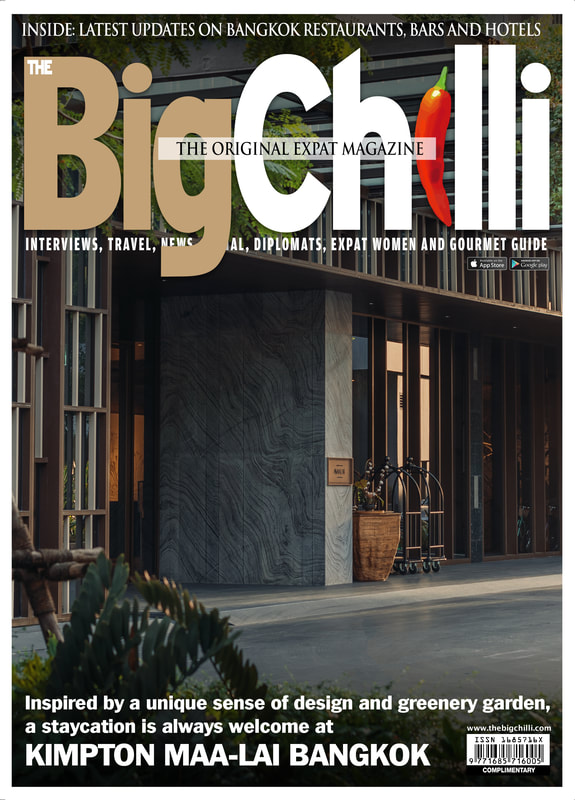Bangkok boasts one of the world’s most interesting Chinatowns, a huge and vibrant area intriguingly different from the rest of the city. Dean Barrett recently immersed himself in its never-ending alleys and discovered a wealth of fascinating traditions and characters, temples and shrines, and reminders of China of old
| IT might seem strange that someone who lives in Bangkok would check into a hotel in Bangkok’s Chinatown but although I had been to Chinatown several times over several decades, I had never actually stayed there. As the city’s Chinatown is one of the world’s greatest I decided the only way to really explore the place is to stay in the area, especially since it was Chinese New Year. And so, finding that most hotels were already booked, I checked into the Riverview Hotel beside a Chinese temple and just a stone’s throw from the Chao Phraya River. |
It was a bit basic – if you’re the type who needs a chocolate mint on his pillow do not check in here – but the hotel turned out to be the perfect choice: It was in the midst of narrow lanes with traditional temples and living quarters along the river and yet it was a mere 15-minute walk to always vibrant Yaowarat Road, the area which would be packed with tourists and booths selling everything from New Year good luck charms and Chinese couplets in gold on red paper strips to delicious Thai and Chinese delicacies.
The view from the hotel’s eighth and ninth floor restaurant was wonderful, especially when paying a mere thousand baht (US$33) a night. Even bikes could be rented for four hours for free. But as I was interested in photographing I knew I would be spending my time walking and chatting with locals.
On the first full day there, tourists were all excited about the “khabuan” or parade expected to begin at about four in the afternoon. I have covered parades many times and knew enough to know that the place for a photographer would be at the assembly point where people would be in costume and I could possibly get some interesting preparation shots, rather than the usual clichéd parade shots.
The view from the hotel’s eighth and ninth floor restaurant was wonderful, especially when paying a mere thousand baht (US$33) a night. Even bikes could be rented for four hours for free. But as I was interested in photographing I knew I would be spending my time walking and chatting with locals.
On the first full day there, tourists were all excited about the “khabuan” or parade expected to begin at about four in the afternoon. I have covered parades many times and knew enough to know that the place for a photographer would be at the assembly point where people would be in costume and I could possibly get some interesting preparation shots, rather than the usual clichéd parade shots.
| I asked several people and of course this being Thailand got several different directions, even from officials, but finally I figured out that the street cleaning ladies on the corner would know because they have to clean up the mess. And so after chatting with them I headed off to find the assembly point. To make a long story short, after nearly three hours of searching, I never found it. Finally, with still an hour to go before the parade would start I did find a massage parlor and had a much-needed foot massage. By four o’clock I sat on a box on the curb awaiting the arrival of the parade and suddenly police and military were lining the street and I was politely asked to stand. Why anyone would need to stand for a parade I didn’t know but I have lived in Thailand long enough never to question Thai logic. Asylums are full of foreigners who attempted to understand Thai reasoning and to ask why. |
Nine cars sped down the street and the police and military dispersed. I asked a nearby official about when the parade was coming and his reply was, “It just came; didn’t you see the cars?” And then it hit me: The much beloved royal princess was in Chinatown for a ceremony at the nearby Odeon Circle and traditional-style Chinese gate (the gate’s position determined by feng-shui) and this is why the Thais had lined the streets. And thus began the spectacle of bewildered foreign tourists asking one another what happened to the parade. And that is why I could not find the assembly point: there wasn’t one.
But now there was a problem: Because on all the streets leading up to the ceremony on the Circle no one was allowed to cross. Which meant I had to maneuver way around the area and then back to Yaowarat Road to seek the shelter at the street-level bar of the very chic and stylish Shanghai Mansion Hotel which, thanks to whatever gods may be, had excellent frozen Daiquiris.
A few years before, I had chatted with what may be the last of Chinatown’s letter-writers, an old man who writes letters in Chinese for those elderly who cannot write or read. I set out in search of him by asking elderly people whom I thought might know, such as the calligraphy expert and women who pluck facial hair using the traditional Chinese method of cotton strings. It was the women who knew where he sets up his outdoor stand but, alas, he would not be there until a day after I left.
What is amazing among the less fortunate in the area is how they live. Some of the wooden doorways were beautiful and almost hidden by trees. Some lived in dark rooms off dark lanes and alleys. Some of the rooms I could see into seemed almost part kitchen and part temple shrine. Some had pictures on the wall which spoke of long-ago manners of dress and the Republican era of China.
There is sometimes an aesthetic beauty in poverty, as I found in Chinatown, but I imagine those living in squalor are too concerned about making a living than to consider the possible visual beauty of their living quarters. And yet every person I spoke with (usually in Thai, occasionally in English or Mandarin) was friendly and happy to chat. On occasion, after photographing someone obviously in need, I politely asked if I could pay for the “service” and while I could, no one ever asked me for money.
But now there was a problem: Because on all the streets leading up to the ceremony on the Circle no one was allowed to cross. Which meant I had to maneuver way around the area and then back to Yaowarat Road to seek the shelter at the street-level bar of the very chic and stylish Shanghai Mansion Hotel which, thanks to whatever gods may be, had excellent frozen Daiquiris.
A few years before, I had chatted with what may be the last of Chinatown’s letter-writers, an old man who writes letters in Chinese for those elderly who cannot write or read. I set out in search of him by asking elderly people whom I thought might know, such as the calligraphy expert and women who pluck facial hair using the traditional Chinese method of cotton strings. It was the women who knew where he sets up his outdoor stand but, alas, he would not be there until a day after I left.
What is amazing among the less fortunate in the area is how they live. Some of the wooden doorways were beautiful and almost hidden by trees. Some lived in dark rooms off dark lanes and alleys. Some of the rooms I could see into seemed almost part kitchen and part temple shrine. Some had pictures on the wall which spoke of long-ago manners of dress and the Republican era of China.
There is sometimes an aesthetic beauty in poverty, as I found in Chinatown, but I imagine those living in squalor are too concerned about making a living than to consider the possible visual beauty of their living quarters. And yet every person I spoke with (usually in Thai, occasionally in English or Mandarin) was friendly and happy to chat. On occasion, after photographing someone obviously in need, I politely asked if I could pay for the “service” and while I could, no one ever asked me for money.
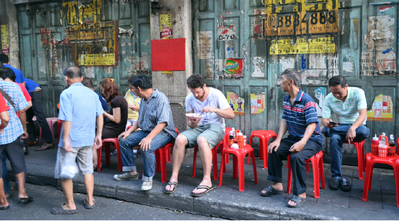
The only time I received a gruff response was at the stalls selling miniature paper versions of items to be burned for the dead, items relatives and friends would be sure to
want in their afterlife. There were of course stacks of Bank of Hell banknotes with the king of Hades on them, paper houses, paper cell phones, paper cigarettes, paper watches, paper dentures, paper jewelry, paper computers, paper cars, paper games,
I explained to the shopkeepers that I am a writer and was wondering why the dead would not want to read books?! Apparently, they had no answer to that and suddenly found themselves otherwise engaged. Perhaps I shall donate some of my titles to the shops for burning for the deceased. After all, what recently deceased in the spirit world would not want to read The Go Go Dancer who Stole my Viagra & other Poetic Tragedies of Thailand?
After a few days and nights of truly immersing myself in Chinatown, it occasionally seemed that I had entered another place, an indefinable locale, almost another dimension, especially as I had booked for a later trip to Beijing just before moving into the hotel. At one point, I noticed my bank, and thought, oh, they have a branch of Bank of Ayudhya here as well. A second later I thought: of course they do, dummy, you’re still in Thailand, remember?
Once a tourist has seen the more obvious tourist attractions such as the famous Thai and Chinese temples and well known shopping streets, the real fun lies in exploring the off-the-beaten lanes, not only those along the riverfront, but also those stretching and winding their way between the major thoroughfares of Yaowarat and Charoen Krung (New Road). Start down one lane which seems sure to end in a dead end and suddenly you find it abruptly turns off and heads in another direction and eventually you emerge back out onto a major street. The true vibrancy and life of the locals is seen in these lanes with their small shrines, tiny restaurants and stalls, wall paintings, lanterns and often beautifully and traditionally decorated doorways.
Some of the characters I met I will not soon forget: the 80-year-old man burning piles of used or abandoned joss-sticks at a temple, the tattooed man living in a shack by the river, the calligrapher and his brilliant calligraphy, and the women using their cotton string women to remove facial hair. And, of course, the children; adorable and all dressed up in lucky red costumes for the lunar new year. And the Pakistani Christian refugee and his three children I met one night outside the beautiful Kalawar church brandishing his UN documents and worried about feeding his children.
Chinatown is best just before and during festivals and celebrations but is fascinating anytime. Just remember not to be afraid to enter into dark lanes and chat with people living in them.
want in their afterlife. There were of course stacks of Bank of Hell banknotes with the king of Hades on them, paper houses, paper cell phones, paper cigarettes, paper watches, paper dentures, paper jewelry, paper computers, paper cars, paper games,
I explained to the shopkeepers that I am a writer and was wondering why the dead would not want to read books?! Apparently, they had no answer to that and suddenly found themselves otherwise engaged. Perhaps I shall donate some of my titles to the shops for burning for the deceased. After all, what recently deceased in the spirit world would not want to read The Go Go Dancer who Stole my Viagra & other Poetic Tragedies of Thailand?
After a few days and nights of truly immersing myself in Chinatown, it occasionally seemed that I had entered another place, an indefinable locale, almost another dimension, especially as I had booked for a later trip to Beijing just before moving into the hotel. At one point, I noticed my bank, and thought, oh, they have a branch of Bank of Ayudhya here as well. A second later I thought: of course they do, dummy, you’re still in Thailand, remember?
Once a tourist has seen the more obvious tourist attractions such as the famous Thai and Chinese temples and well known shopping streets, the real fun lies in exploring the off-the-beaten lanes, not only those along the riverfront, but also those stretching and winding their way between the major thoroughfares of Yaowarat and Charoen Krung (New Road). Start down one lane which seems sure to end in a dead end and suddenly you find it abruptly turns off and heads in another direction and eventually you emerge back out onto a major street. The true vibrancy and life of the locals is seen in these lanes with their small shrines, tiny restaurants and stalls, wall paintings, lanterns and often beautifully and traditionally decorated doorways.
Some of the characters I met I will not soon forget: the 80-year-old man burning piles of used or abandoned joss-sticks at a temple, the tattooed man living in a shack by the river, the calligrapher and his brilliant calligraphy, and the women using their cotton string women to remove facial hair. And, of course, the children; adorable and all dressed up in lucky red costumes for the lunar new year. And the Pakistani Christian refugee and his three children I met one night outside the beautiful Kalawar church brandishing his UN documents and worried about feeding his children.
Chinatown is best just before and during festivals and celebrations but is fascinating anytime. Just remember not to be afraid to enter into dark lanes and chat with people living in them.
Travel Notes
AS far as hotels go, the middle-class Chinatown Hotel on Yaowarat and the more upper-class Shanghai Mansion Hotel opposite are perfectly located in the middle of Chinatown and there are other hotels along the street. There are also some very clean hostels, perfectly located, such as the Old Town and the Loftel. Both are very cheap, both have cafes, but although they offer private rooms even those have to share a bathroom. (The latter offers various room types including a “female-mixed dormitory.” Remember what I said about not getting involved in Thai logic).
Also, although another station on the MRT subway line is being dug, as of this writing the closest station is the end of the line at the Hualampong Railway Station. From there there are taxis, tuk tuks (samlors) and motorcycles, or if it is not the hot season and you are not burdened with luggage, you can walk. Although work for the new station is digging up an old district of Chinatown, fortunately, the area is large enough and old enough to keep its character and unique identity.
AS far as hotels go, the middle-class Chinatown Hotel on Yaowarat and the more upper-class Shanghai Mansion Hotel opposite are perfectly located in the middle of Chinatown and there are other hotels along the street. There are also some very clean hostels, perfectly located, such as the Old Town and the Loftel. Both are very cheap, both have cafes, but although they offer private rooms even those have to share a bathroom. (The latter offers various room types including a “female-mixed dormitory.” Remember what I said about not getting involved in Thai logic).
Also, although another station on the MRT subway line is being dug, as of this writing the closest station is the end of the line at the Hualampong Railway Station. From there there are taxis, tuk tuks (samlors) and motorcycles, or if it is not the hot season and you are not burdened with luggage, you can walk. Although work for the new station is digging up an old district of Chinatown, fortunately, the area is large enough and old enough to keep its character and unique identity.

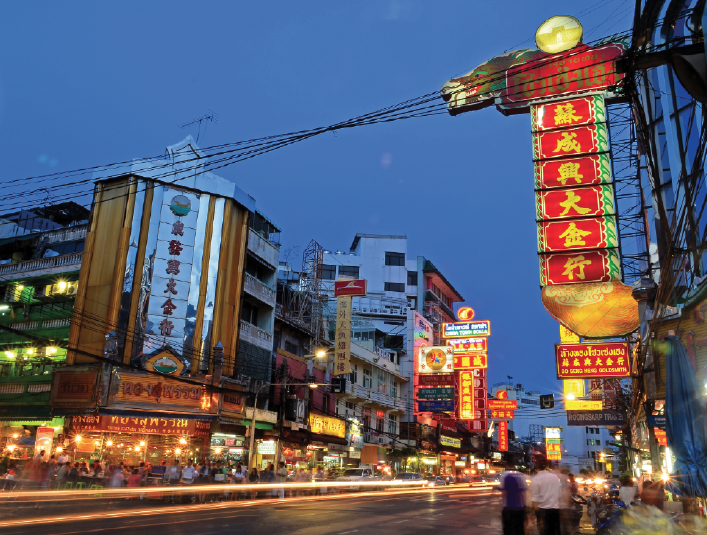
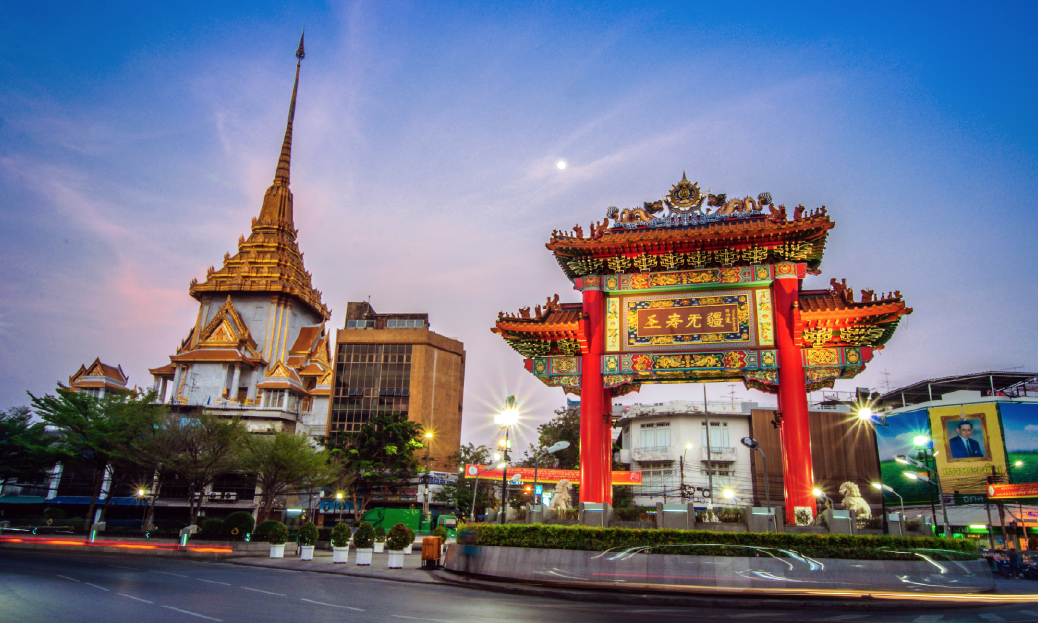
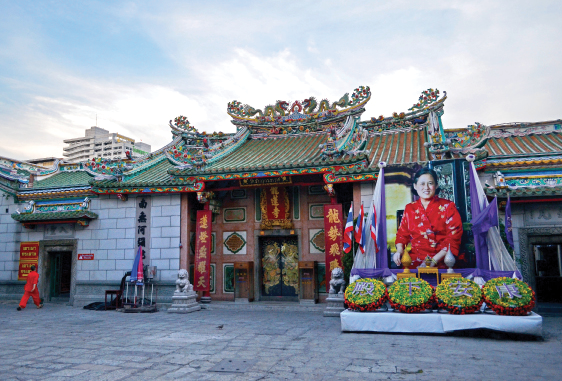
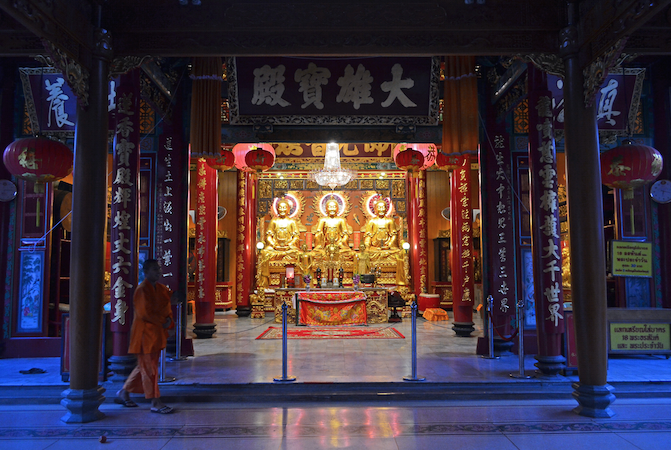
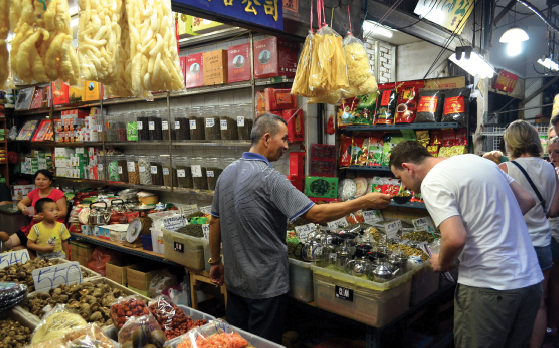
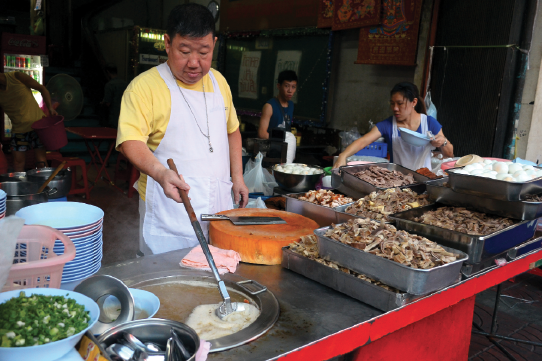
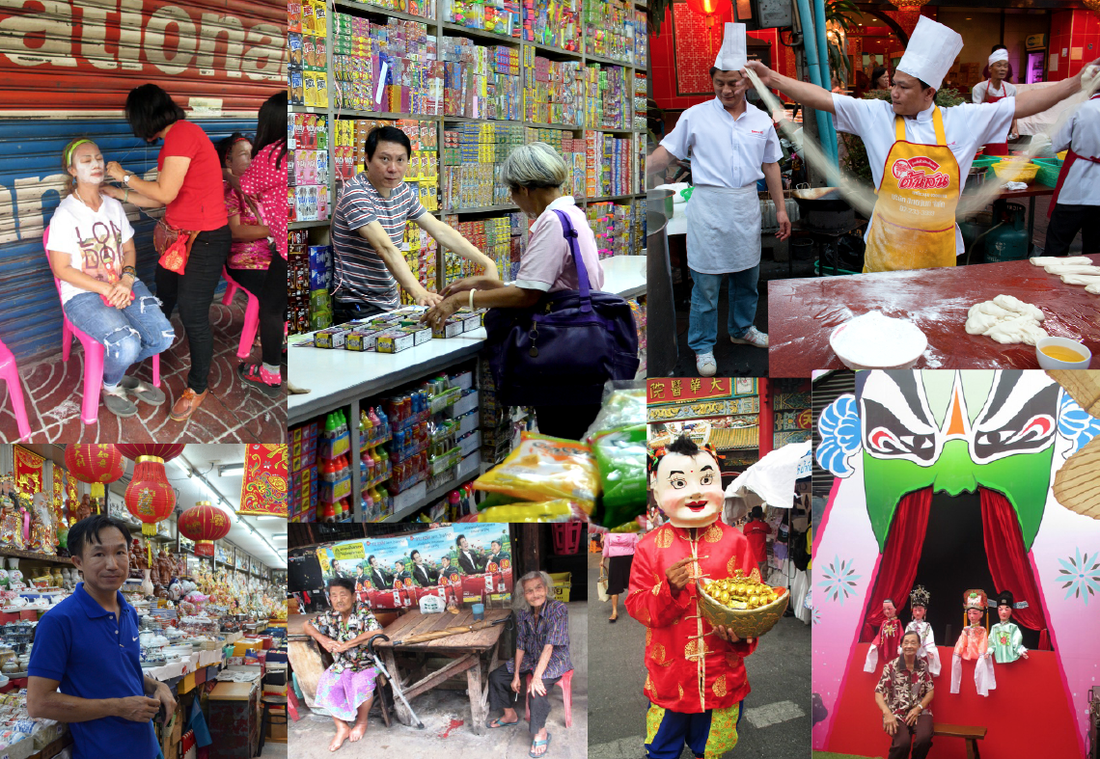
 RSS Feed
RSS Feed





